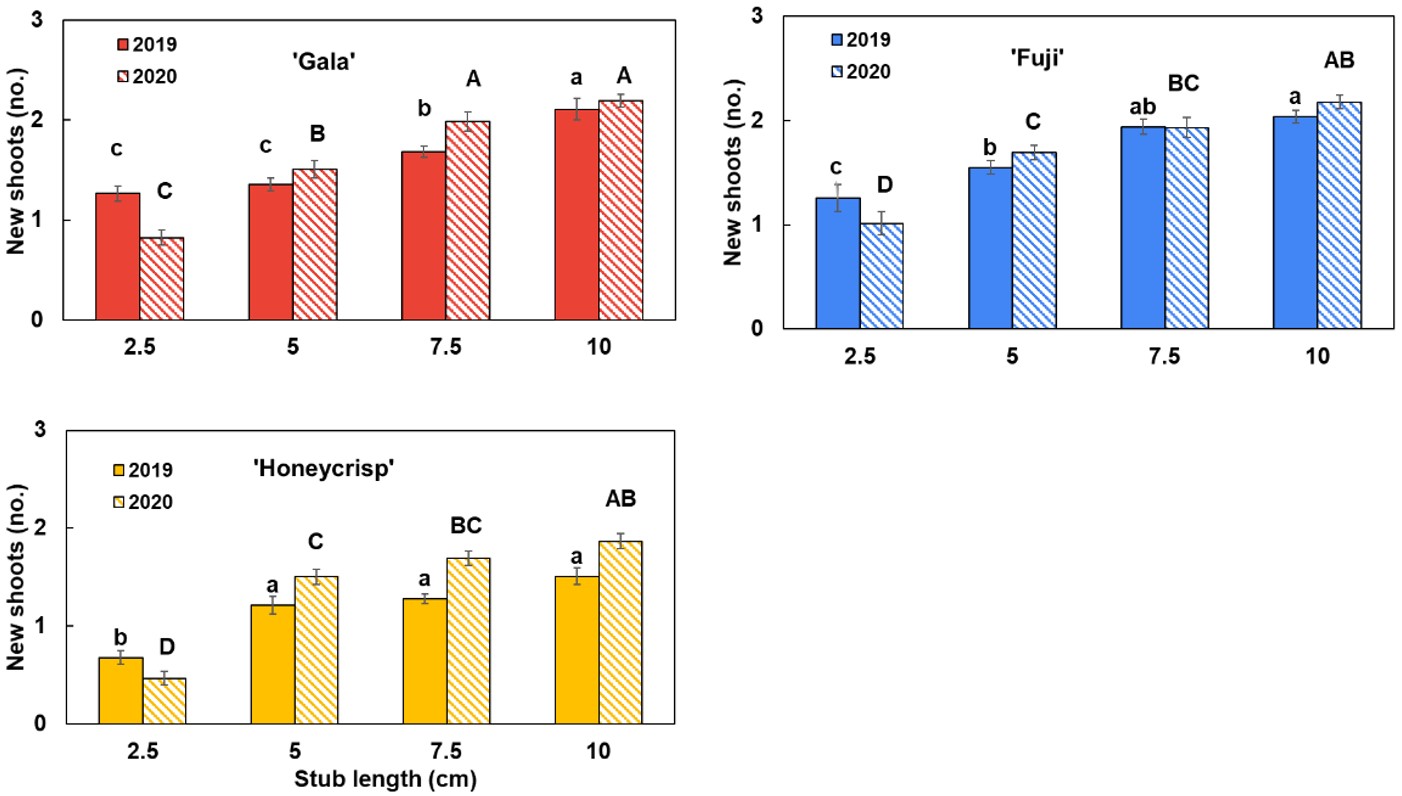Stub length for renewal cuts in high-density apples
Research by Todd Einhorn on the impact of stub length on renewal shoots in Gala, Fuji and Honeycrisp.

In most high-density training systems (e.g., Tall Spindle and Super Spindle), lateral branches are periodically removed during dormant pruning. This encourages growth of less vigorous wood that is more fruitful. Generally, one to two limbs are removed using thinning cuts that leave behind a stub. But what is the appropriate length of the stub?
The correct answer is it depends. Longer stubs (4 inches) would be expected to promote more vigor. This might be beneficial to weaker growing cultivars. It might also generate multiple shoots to select from as a renewal shoot. However, it could also be detrimental, creating a denser canopy with more shade and poor sunlight interception and taking greater labor to maintain.
Stub length might not make a difference at all. In fact, previous research by Jim Schupp at Penn State University on Gala showed there was no advantage to stub length (0.5 versus 2 centimeters) or orientation of the pruning cut (perpendicular versus beveled up or down). Other cultivars and lengths were not considered in this trial.
To investigate the importance of stub length and cut orientation, a trial was established by Todd Einhorn from Michigan State University at the Clarksville Research Center in 2019 and 2020 in fourth leaf Gala, Honeycrisp and Fuji on G.41 trees trained to tall spindle system (3 feet by 11 feet). Stubs were cut at 1-, 2-, 3- and 4-inch lengths. To maintain uniformity, trees were selected on canopy and trunk size, and the same number of intact limbs were left on each tree (13). In the fall, data were collected on stub diameter, number of renewal shoots per stub, length of renewal shoots and cut orientation.
Renewal shoot number and length
For all cultivars, longer stubs produced more renewal shoots. Honeycrisp produced fewer return shoots overall than Gala or Fuji, as expected for this less vigorous variety. In addition, the total length of renewal shoots (sum of shoot lengths) was greater for longer renewal stubs. This is also expected, as we expect a longer shoot to produce more vigor. Fuji and Gala were far more vigorous than Honeycrisp.

Gala
Most of the stubs of any length produced at least one renewal shoot. For 1-inch stubs, only 30% and 10% did not produce any shoots in 2019 and 2020, respectively. Only 5% of 2-inch stubs did not produce a renewal shoot. The percentage of stubs returning two or more shoots increased with longer stub length. The stub length influenced the length of the renewal shoots as well. In general, a longer renewal shoot (12 inches) is desirable for Gala. This was achieved more reliably with 1–2-inch stubs, compared to shorter shoots (6 inches) with a longer stub.

Fuji
Despite being a vigorous cultivar, 1-inch stubs may not be long enough to guarantee renewal. In the two years, 40% and 20% of stubs didn’t produce any shoots. Renewal was excellent for longer stubs: 95% of 2-inch stubs produced at least one renewal shoot and 80% of 4-inch stubs produced at least two renewal shoots. The length of the shoots produced was influenced by stub length as well.
Generally, long stub length encouraged growth of a long renewal shoot. For stubs with multiple renewal shoots, one shoot was consistently longer than second or third renewal shoots, and the length of the second or third renewal shoots wasn’t affected by stub length. Therefore, to encourage a longer shoot (12-18 inches), Michigan State University Extension recommends leaving a longer stub and vice versa.

Honeycrisp
As expected, this weaker growing cultivar needs a considerably longer stub length to guarantee renewal shoots. A large number of 1-inch stubs (70% and 40% in 2019 and 2020) did not produce any shoots, while most (90%) of 2-inch stubs produced a single shoot. Longer stubs (3 and 4 inches) generally produced one or two renewal shoots, and very few (less than 10%) produced more than two. The longer the stub, the longer the renewal shoots. Therefore, it is best to leave a longer renewal stub for this cultivar.

Stub orientation
In general, orientation of the stub (perpendicular to the tree compared to bevel cuts) had very little influence on the number of renewal shoots or the orientation of these shoots. This is somewhat surprising. Conventional wisdom has been to use a bevel cut to encourage a bud to break below the cut to produce a more horizontal branch. However, this was not found to be true for almost any of the cultivars for any stub length. The only exception was for 1-inch stubs in Honeycrisp, which produced more horizontal renewal shoots; but this is not important, because short stubs were not typically sufficient for renewal in Honeycrisp.
Takeaways
Several important trends were observed in this research trial.
- Longer stubs produce more renewal shoots.
- If multiple shoots are produced, the length of the longest shoot was typically longer.
- Honeycrisp: Renewal stubs should be at least 2 inches.
- Fuji: Renewal stubs of 2 inches produced 12–16-inch shoots, compared to a 3–4-inch stub produced 6–8-inch shoots.
- Gala: A 1–2-inch stub is sufficient for renewal.
- Orientation of stub did not influence the orientation of the renewal shoots.
How long should a renewal stub be? The correct answer is still: it depends. Target shoot length of renewal shoot depends on the cultivar, the grower and the system.



 Print
Print Email
Email